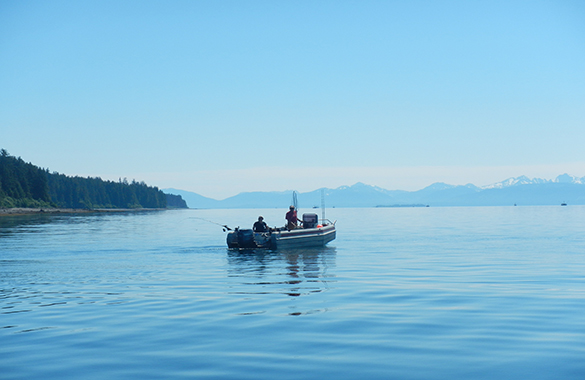Even if you are a seasoned boater, there are a few important rules you need to keep in mind when navigating Alaska’s waters.
The water around Doc Warner’s is usually calm, so it is easy to forget you are cruising on an ocean. However, winds and opposing currents can cause rough waters. The important thing to remember when navigating rough waters is to slow down and ride the waves to safety. Do not allow the waves to hit you in such a way that you take on more than a splash of water. Keep in mind that you can troll your way out of almost any situation. Never go ashore in large waves, as beaching will cause the next wave to come over the back of the boat and swamp it.
Always keep an eye on the weather, as fog and winds can change quickly in Southeast Alaska. If you start seeing whitecaps, it is an indicator of current changes. Check your tide tables to help predict current strength and changes. A dark line on the water’s horizon indicates rougher water ahead.
There are many obstacles underwater you cannot see but should be aware of while operating a boat. GPS is a good start in helping you finding your way, but you should not rely on it exclusively. At the lodge, we provide you with a map of all the reefs in our waters, and you should also look out for markers and floating obstacles. For instance, a branch sticking out of the water may be attached to a larger log floating just beneath the surface. Similarly, ducks sitting in a row on the water indicate a submerged log. When crossing a scum line of seaweed and debris slow down and take time to dodge floating objects. Avoiding obstacles helps to prevent propeller damage.
One of the most exciting adventures our guests enjoy is encountering wildlife. You are likely to see whales, sea otters, birds, or land mammals during your stay. Keep your distance and refrain from chasing any animals. Spotting a geyser breaking through the water’s surface alerts you to the presence of whales; determine their direction of travel and give them a wide berth.
Finally, when driving a boat, you are controlling the back of the boat, which is the opposite of what happens in your car. When approaching the dock or other boats, go very slowly so you can compensate for currents and wind. Allowing time and space for maneuvering will make you a better boat captain.



